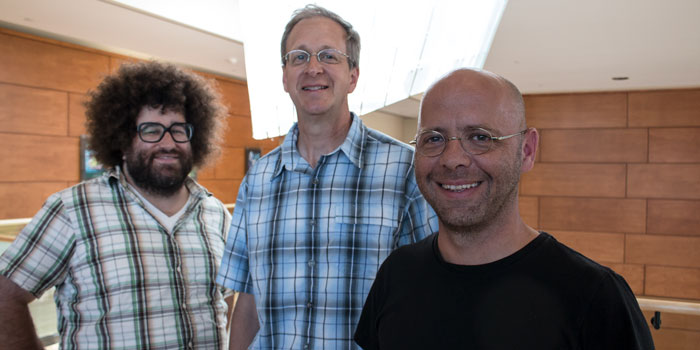
From left: Yaniv Brandvain, David Zarkower, Heath Blackmon
Third in a four-part series on the first round of research projects funded through the College of Biological Sciences' Grand Challenges in Biology Postdoctoral Program.
It all started with beetles. As a graduate student considering the invertebrates’ chromosomes, Heath Blackmon observed that the insects drop their Y chromosomes on a fairly regular basis. But why? Now a post-doctoral researcher in the College of Biological Sciences, he spotted an opportunity to investigate a question with very real consequences for humans with chromosomal disorders such as Turner's and Klinefelter syndromes.
Humans and many other animals depend on recombination for segregation of chromosomes for reproduction, but sometimes things don’t go to plan and Blackmon thinks he may know why. Based on his work with beetles — Blackmon aggregated data on about 1,000 species, which he used to estimate rates of sex chromosome evolution — he built a hypothesis. He made a simple but potentially powerful observation about the mechanisms at work in meiotic segregation. He’s calling it the fragile Y hypothesis.
“With sex chromosomes there’s a region called the PAR that has to come together during meiosis to make sperm. One chromosome from the mother and one from the father have to cross over and link together right there,” says Blackmon. “When that region gets small I think it’s harder for that linkage to occur that holds them together so you’re more likely to make sperm without a sex chromosome which can produce something like Turner’s Syndrome where you have an offspring lacking a sex chromosome.”
Blackmon is poised to test his hypothesis with the help of faculty mentors Yaniv Brandvain, who studies theoretical population genetics, and David Zarkower, an expert in the mechanisms underpinning sex determination.
The collaboration is unique for a few reasons. It allows Blackmon to bridge theory and experimentation to test his hypothesis across species. The tools to do that have improved dramatically. “The most useful data is the genotype of actual sperm, to get that we need to visualize chromosomes inside sperm,” says Blackmon. “They are packed tightly. Our ability to visualize that was very difficult before the early 2000s. Experiments were very complicated and time consuming and it was hard to get enough data.” With the help of the Zarkower lab, Blackmon can do the legwork needed to support the theoretical work.
“The theory for many years largely focused on why the PAR region gets smaller and smaller,” says Blackmon. “We understand a lot about how sexual antagonism and different kinds of selection can force that region to get small and, in most mammals, its very small relative to the size of the chromosome, but nobody has really thought about effects that may have on the reliability of meiosis.”
If Blackmon is right, his insights could provide a much-needed roadmap for researchers developing treatments for chromosomal disorders. Ultimately, says Blackmon, a better understanding of the the forces acting on sex chromosomes could shed light on the way genomes evolve. — Stephanie Xenos